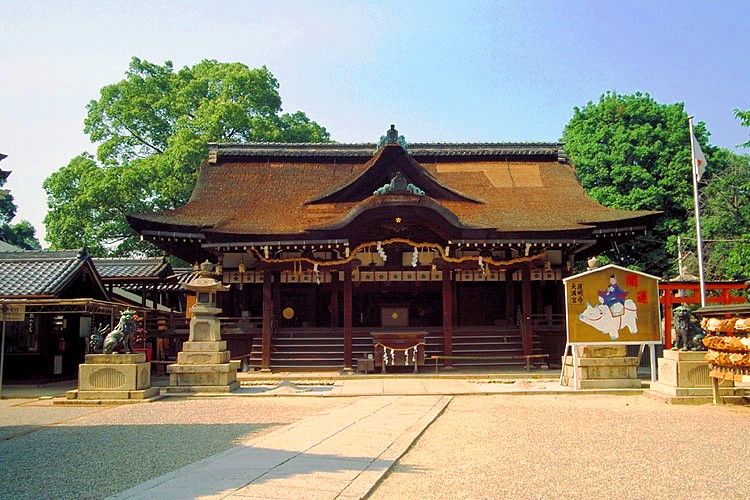Dōmyōji Tenmangū Shrine
更新日:2020年10月08日
Dōmyōji Tenmangū Shrine is a popular place to pray for academic success and to enjoy the spring plum blossoms, both of which have close associations with the shrine’s main deity, Sugawara no Michizane (845–903).
Michizane was an influential scholar, poet, and minister in the court of Emperor Uda (876–931). After Michizane’s death in 903, he was deified as the kami of scholarship and literature, Tenman-Tenjin. The hundreds of Tenmangū shrines built throughout Japan are dedicated to him. Students go to these shrines to leave a votive tablet or ema before a large exam.
At many Tenmangū shrines there is a bronze statue of a bull. Worshippers touch the bull’s body where they would like to see an improvement in their own body. The bull’s connection to Michizane comes from a legend told about the scholar’s funeral procession. The bull pulling the cart carrying Michizane’s body suddenly came to a stop. This was taken as a sign from heaven, and Michizane was promptly buried at that spot.
Dōmyōji Tenmangū Shrine has been entrusted with the only known relics of Michizane—objects used by Michizane during his life: an ivory baton indicating his rank, a white porcelain inkstone, an ivory and tortoiseshell comb, an ornamental knife, leather belts, and a copper mirror carved with a phoenix and a koto player. All the items are recognized as National Treasures and are displayed only on special days.
Most Tenmangū shrines have Japanese plum trees planted within the grounds because Michizane was a great admirer of plum blossoms and wrote many poems about them. Behind the main hall of Dōmyōji Tenmangū lies a grove of over 800 trees including some 80 different varieties. From mid-February to mid-March, the shrine holds a famous plum festival, where visitors can enjoy the sweet-smelling blossoms along with performances of traditional music and martial arts.
Dōmyōji is one of the few Buddhist convents still in operation in Japan. Within its grounds are an impeccably tended rock garden and a thousand-year-old statue of Kannon.
Kannon, the bodhisattva of compassion, is the central object of worship at Dōmyōji. The statue is believed to have been carved by Sugawara no Michizane (845–903), the noted scholar and poet who was later deified as the Shinto kami of learning, Tenjin. The statue is approximately a meter high and carved from a single piece of Japanese cypress. Kannon is depicted atop a lotus blossom and is wearing a crown made of 10 incarnations of Kannon’s head. Each head represents a stage on the bodhisattva’s path. Above the 10 heads of Kannon is the head of Amida Buddha, representing full enlightenment. The statue is displayed to the public on the 18th and 25th of each month.
It might seem strange that a man who later became a Shinto deity carved a Buddhist statue. But from the sixth century, when Buddhism was introduced to Japan, to the end of the nineteenth century, Buddhism and Shinto were not seen as distinct religious traditions. Shinto kami were believed to be Buddhist deities and Buddhist deities had Shinto kami avatars. In fact, some of Dōmyōji’s buildings were moved from nearby Dōmyōji Tenmangū Shrine when laws enacted in 1868 forced the Buddhism and Shinto to separate.

Dōmyōji Tenmangū Shrine
- お問い合わせ
-
教育委員会事務局教育部 文化財保護課
〒583-8583
大阪府藤井寺市藤井寺3丁目1番20号アイセルシュラホール2階
電話番号:072-939-1111 (代表)
072-939-1419 (文化財担当、世界遺産担当)
ファックス番号:072-952-7806


